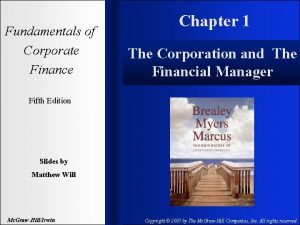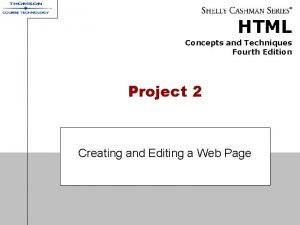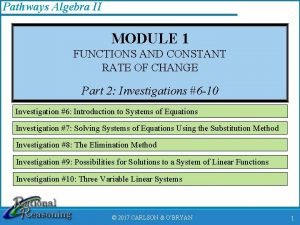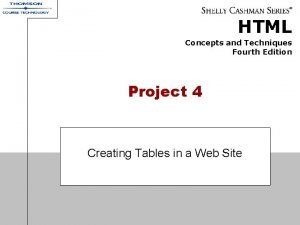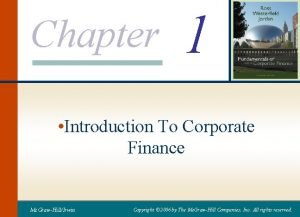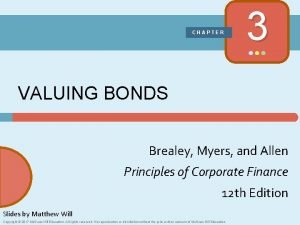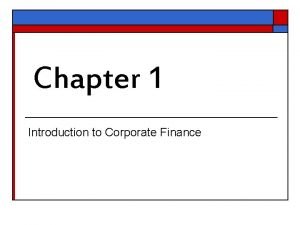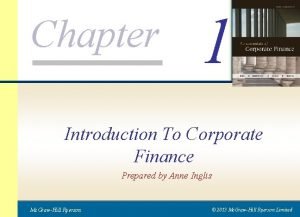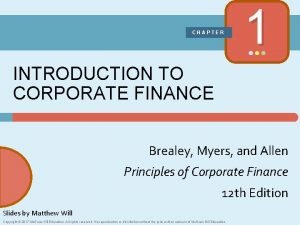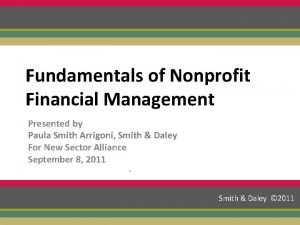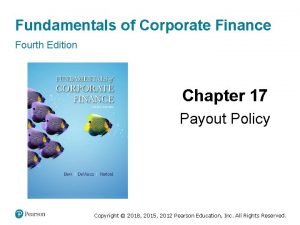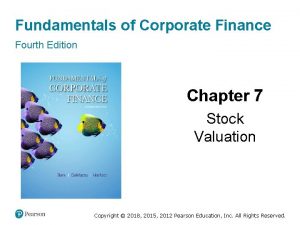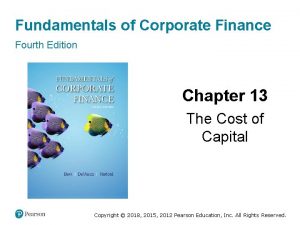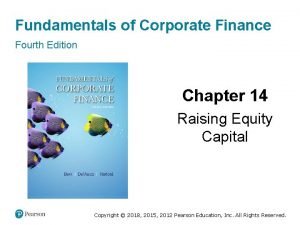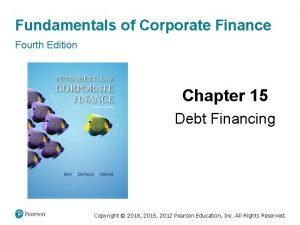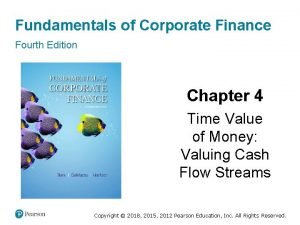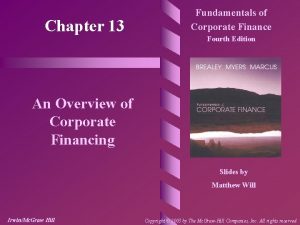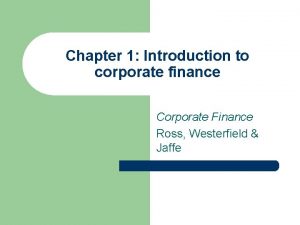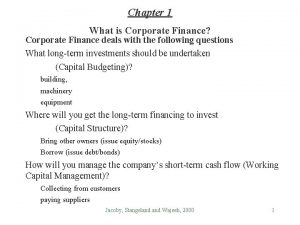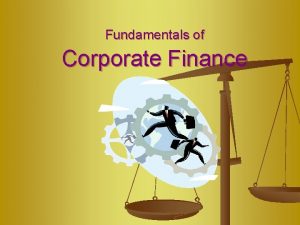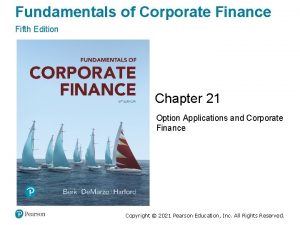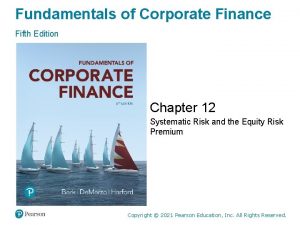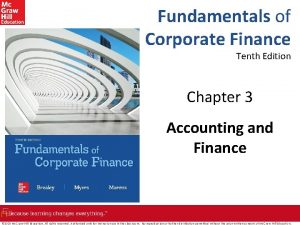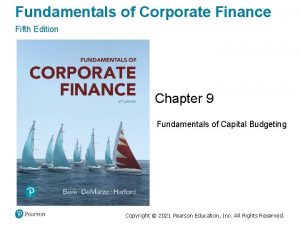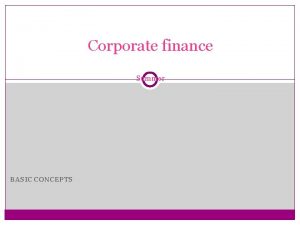Fundamentals of Corporate Finance Fourth Edition Chapter 8

































![8. 7 Putting It All Together (2 of 4) [Table 8. 5 continued] IRR 8. 7 Putting It All Together (2 of 4) [Table 8. 5 continued] IRR](https://slidetodoc.com/presentation_image_h2/744de96ab9f4962b9aecc5323b3864c2/image-34.jpg)
![8. 7 Putting It All Together (3 of 4) [Table 8. 5 continued] Payback 8. 7 Putting It All Together (3 of 4) [Table 8. 5 continued] Payback](https://slidetodoc.com/presentation_image_h2/744de96ab9f4962b9aecc5323b3864c2/image-35.jpg)
- Slides: 35

Fundamentals of Corporate Finance Fourth Edition Chapter 8 Investment Decision Rules Copyright © 2018, 2015, 2012 Pearson Education, Inc. All Rights Reserved.

8. 1 The NPV Decision Rule (1 of 5) • Net Present Value – Most firms measure values in terms of Net Present Value–that is, in terms of cash today NPV = PV (Benefits) – PV (Costs) (Eq. 8. 1) Copyright © 2018, 2015, 2012 Pearson Education, Inc. All Rights Reserved.

8. 1 The NPV Decision Rule (5 of 5) • The NPV decision rule implies that we should: – Accept positive-NPV projects; accepting them is equivalent to receiving their NPV in cash today, and – Reject negative-NPV projects; accepting them would reduce the value of the firm, whereas rejecting them has no cost (NPV = 0) Copyright © 2018, 2015, 2012 Pearson Education, Inc. All Rights Reserved.

8. 2 Using the NPV Rule (1 of 6) • Organizing the Cash Flows and Computing the NPV: – A take-it-or-leave-it decision – A fertilizer company can create a new environmentally friendly fertilizer at a large savings over the company’s existing fertilizer – The fertilizer will require a new factory that can be built at a cost of $81. 6 million. Estimated return on the new fertilizer will be $28 million after the first year, and will last for four years Copyright © 2018, 2015, 2012 Pearson Education, Inc. All Rights Reserved.

8. 2 Using the NPV Rule (2 of 6) • Organizing Cash Flows and Computing NPV – The following timeline shows the estimated cash flows: Copyright © 2018, 2015, 2012 Pearson Education, Inc. All Rights Reserved.

8. 2 Using the NPV Rule (3 of 6) • Given a discount rate r, the NPV is: (Eq. 8. 2) • We can also use the annuity formula: (Eq. 8. 3) Copyright © 2018, 2015, 2012 Pearson Education, Inc. All Rights Reserved.

8. 2 Using the NPV Rule (4 of 6) • Organizing Cash Flows and Computing NPV – If the company’s cost of capital is 10%, the NPV is $7. 2 million and they should undertake the investment Copyright © 2018, 2015, 2012 Pearson Education, Inc. All Rights Reserved.

8. 2 Using the NPV Rule (5 of 6) • The NPV Profile – The NPV depends on cost of capital – NPV profile graphs the NPV over a range of discount rates – Based on this data the NPV is positive only when the discount rates are less than 14% Copyright © 2018, 2015, 2012 Pearson Education, Inc. All Rights Reserved.

Figure 8. 1 NPV of Project Copyright © 2018, 2015, 2012 Pearson Education, Inc. All Rights Reserved.

8. 2 Using the NPV Rule (6 of 6) • Measuring the Sensitivity with IRR – If you are unsure of your cost of capital estimate, it is important to determine how sensitive your analysis is to errors in this estimate – The IRR can provide this information • Alternative Rules Versus the NPV Rule – When evaluating alternative rules for project selection, understand that alternative investment rules may or may not give the same answer as the NPV rule – When the rules conflict, always base your decision on the NPV rule Copyright © 2018, 2015, 2012 Pearson Education, Inc. All Rights Reserved.

8. 3 Alternative Decision Rules (3 of 11) • The Internal Rate of Return Rule – Take any investment opportunity where IRR exceeds the opportunity cost of capital Copyright © 2018, 2015, 2012 Pearson Education, Inc. All Rights Reserved.

8. 3 Alternative Decision Rules (4 of 11) • Weakness in IRR – In most cases IRR rule agrees with NPV for standalone projects if all negative cash flows precede positive cash flows – In other cases the IRR may disagree with NPV Copyright © 2018, 2015, 2012 Pearson Education, Inc. All Rights Reserved.

Figure 8. 2 The Most Popular Decision Rules Used by CFOs Copyright © 2018, 2015, 2012 Pearson Education, Inc. All Rights Reserved.

8. 3 Alternative Decision Rules (5 of 11) • Delayed Investments – Two competing endorsements: § Offer A: single payment of $1 million upfront § Offer B: $500, 000 per year at the end of the next three years § Estimated cost of capital is 10% – Opportunity timeline: Copyright © 2018, 2015, 2012 Pearson Education, Inc. All Rights Reserved.

8. 3 Alternative Decision Rules (6 of 11) • The NPV is: • Set NPV to zero and solve for r to get IRR. Copyright © 2018, 2015, 2012 Pearson Education, Inc. All Rights Reserved.

8. 3 Alternative Decision Rules (7 of 11) • 23. 38% > the 10% opportunity cost of capital, so according to IRR, Option A best • However, NPV shows that Option B is best • To resolve the conflict we can show a NPV Profile Copyright © 2018, 2015, 2012 Pearson Education, Inc. All Rights Reserved.

8. 3 Alternative Decision Rules (8 of 11) • Multiple IRRs – Suppose the cash flows in the previous example change – The company has agreed to make an additional payment of $600, 000 in 10 years Copyright © 2018, 2015, 2012 Pearson Education, Inc. All Rights Reserved.

8. 3 Alternative Decision Rules (9 of 11) • The new timeline: • The NPV of the new investment opportunity is: • If we plot the NPV profile, we see that it has two IRRs! Copyright © 2018, 2015, 2012 Pearson Education, Inc. All Rights Reserved.

Figure 8. 4 NPV with Additional Deferred Payments Copyright © 2018, 2015, 2012 Pearson Education, Inc. All Rights Reserved.

8. 4 Choosing Among Projects (1 of 8) • Mutually Exclusive Projects. – Can’t just pick the project with a positive NPV – The projects must be ranked and the best one chosen – Pick the project with the highest NPV Copyright © 2018, 2015, 2012 Pearson Education, Inc. All Rights Reserved.

Example 8. 3 NPV and Mutually Exclusive Projects (1 of 5) Problem: • You own a small piece of commercial land near a university. You are considering what to do with it. You have been approached with an offer to buy it for $220, 000. You are also considering three alternative uses yourself: a bar, a coffee shop, and an apparel store. You assume that you would operate your choice indefinitely, eventually leaving the business to your children. Copyright © 2018, 2015, 2012 Pearson Education, Inc. All Rights Reserved.

Example 8. 3 NPV and Mutually Exclusive Projects (2 of 5) Problem: • You have collected the following information about the uses. What should you do? Blank Initial Investment Cash flow in the First Year (CF 1) Growth rate (g) Cost of capital (r) Bar $400, 000 $60, 000 3. 5% 12% Coffee Shop $200, 000 $40, 000 3% 10% Apparel Store $500, 000 $75, 000 3% 13% Copyright © 2018, 2015, 2012 Pearson Education, Inc. All Rights Reserved.

Example 8. 3 NPV and Mutually Exclusive Projects (3 of 5) Solution: Plan: • Since you can develop only one project (you only have one piece of land), these are mutually exclusive projects. In order to decide which project is most valuable, you need to rank them by NPV. Each of these projects (except for selling the land) has cash flows that can be valued as a growing perpetuity, so from Chapter 4, the present value of the inflows is • The NPV of each investment will be Copyright © 2018, 2015, 2012 Pearson Education, Inc. All Rights Reserved.

Example 8. 3 NPV and Mutually Exclusive Projects (4 of 5) Execute: • The NPVs are: Alternative NPV Coffee Shop $371, 429 Bar $305, 882 Apparel Store $250, 000 Sell the Land $220, 000 • You should choose the coffee shop. Copyright © 2018, 2015, 2012 Pearson Education, Inc. All Rights Reserved.

Example 8. 3 NPV and Mutually Exclusive Projects (5 of 5) Evaluate: • All the alternatives have positive NPVs, but you can take only one of them, so you should choose the one that creates the most value. • Even though the coffee shop has the lowest cash flows, its lower start-up cost coupled with its lower cost of capital (it is less risky) make it the best choice. Copyright © 2018, 2015, 2012 Pearson Education, Inc. All Rights Reserved.

Example 8. 3 a NPV and Mutually Exclusive Projects (1 of 5) Problem: • You own a small piece of commercial land near a university. You are considering what to do with it. You have been approached recently with an offer to buy it for $600, 000. You are also considering three alternative uses of the land for yourself: a laundromat, a bakery, and a bike shop. You assume that you would operate your choice indefinitely, eventually leaving the business to your children. Copyright © 2018, 2015, 2012 Pearson Education, Inc. All Rights Reserved.

Example 8. 3 a NPV and Mutually Exclusive Projects (2 of 5) Problem: • You have collected the following information about the uses. What should you do? Blank Initial Investment Cash flow in the First Year Growth rate Cost of capital Laundromat $200, 000 $35, 000 2. 0% 7. 0% Bakery $750, 000 $45, 000 3. 5% 6. 5% Bike Shop $800, 000 $40, 000 4. 5% 7. 0% Copyright © 2018, 2015, 2012 Pearson Education, Inc. All Rights Reserved.

Example 8. 3 a NPV and Mutually Exclusive Projects (3 of 5) Solution: Plan: • Since you can only do one project (you only have one piece of land), these are mutually exclusive projects. In order to decide which project is most valuable, you need to rank them by NPV. Each of these projects (except for selling the land) has cash flows that can be valued as a growing perpetuity, the present value of the inflows is • The NPV of each investment will be Copyright © 2018, 2015, 2012 Pearson Education, Inc. All Rights Reserved.

Example 8. 3 a NPV and Mutually Exclusive Projects (4 of 5) Execute: • The NPVs are: Alternative NPV Laundromat $500, 000 Bakery $750, 000 Bike Shop $800, 000 Sell the Land $600, 000 • Based on the rankings the bike shop should be chosen. Copyright © 2018, 2015, 2012 Pearson Education, Inc. All Rights Reserved.

Example 8. 3 a NPV and Mutually Exclusive Projects (5 of 5) Evaluate: • All of the alternatives have positive NPVs, but you can only take one of them, so you should choose the one that creates the most value. • Even though the Laundromat has the lowest start-up costs, the higher cash flows of the bike shop, along with its higher growth rate, makes it the best choice. Copyright © 2018, 2015, 2012 Pearson Education, Inc. All Rights Reserved.

8. 4 Choosing Among Projects (2 of 8) • Differences in Scale – A 10% IRR can have very different value implications for an initial investment of $1 million vs. an initial investment of $100 million Copyright © 2018, 2015, 2012 Pearson Education, Inc. All Rights Reserved.

8. 4 Choosing Among Projects (8 of 8) • The Bottom Line on IRR – Picking the investment opportunity with the largest IRR can lead to a mistake – In general, it is dangerous to use the IRR in choosing between projects – Always rely on NPV Copyright © 2018, 2015, 2012 Pearson Education, Inc. All Rights Reserved.

8. 7 Putting It All Together (1 of 4) Table 8. 5 Summary of Decision Rules NPV Blank Definition • The difference between the present value of an investment’s benefits and the present value of its costs Rule • Take any investment opportunity where the NPV is positive; turn down any opportunity where it is negative Advantages • Corresponds directly to the impact of the project on the firm’s value • Direct application of the Valuation Principle Disadvantages • Relies on an accurate estimate of the discount rate • Can be time-consuming to compute Copyright © 2018, 2015, 2012 Pearson Education, Inc. All Rights Reserved.
![8 7 Putting It All Together 2 of 4 Table 8 5 continued IRR 8. 7 Putting It All Together (2 of 4) [Table 8. 5 continued] IRR](https://slidetodoc.com/presentation_image_h2/744de96ab9f4962b9aecc5323b3864c2/image-34.jpg)
8. 7 Putting It All Together (2 of 4) [Table 8. 5 continued] IRR Blank Definition • The interest rate that sets the net present value of the cash flows equal to zero; the average return of the investment Rule • Take any investment opportunity where its IRR exceeds the opportunity cost of capital; turn down any opportunity where its IRR is less than the opportunity cost of capital Advantages • Related to the NPV rule and usually yields the same (correct) decision Disadvantages • • Hard to compute Multiple IRRs lead to ambiguity Cannot be used to choose among projects Can be misleading if inflows come before outflows Copyright © 2018, 2015, 2012 Pearson Education, Inc. All Rights Reserved.
![8 7 Putting It All Together 3 of 4 Table 8 5 continued Payback 8. 7 Putting It All Together (3 of 4) [Table 8. 5 continued] Payback](https://slidetodoc.com/presentation_image_h2/744de96ab9f4962b9aecc5323b3864c2/image-35.jpg)
8. 7 Putting It All Together (3 of 4) [Table 8. 5 continued] Payback Period Blank Definition • The amount of time it takes to pay back the initial investment Rule • Accept the project if the payback period is less than a prespecified length of time—usually a few years; otherwise, turn it down Advantages • Simple to compute • Favors liquidity Disadvantages • No guidance as to correct payback cutoff • Ignores cash flows after the cutoff completely • Not necessarily consistent with maximizing shareholder wealth Copyright © 2018, 2015, 2012 Pearson Education, Inc. All Rights Reserved.
 Fundamentals of corporate finance 3rd canadian edition
Fundamentals of corporate finance 3rd canadian edition Fundamentals of corporate finance third canadian edition
Fundamentals of corporate finance third canadian edition Fundamentals of corporate finance fifth edition
Fundamentals of corporate finance fifth edition Corporate finance 6th edition
Corporate finance 6th edition Fundamentals of corporate finance chapter 6 solutions
Fundamentals of corporate finance chapter 6 solutions Fundamentals of corporate finance (doc or html) file
Fundamentals of corporate finance (doc or html) file Fundamentals of corporate finance, chapter 1
Fundamentals of corporate finance, chapter 1 Objectives of corporate governance
Objectives of corporate governance Corporate finance tenth edition
Corporate finance tenth edition Corporate finance tenth edition
Corporate finance tenth edition Corporate finance tenth edition
Corporate finance tenth edition Corporate finance tenth edition
Corporate finance tenth edition Corporate finance tenth edition
Corporate finance tenth edition Project 2 fourth edition
Project 2 fourth edition Algebra 2 module 1 answer key
Algebra 2 module 1 answer key Ethics in information technology fourth edition
Ethics in information technology fourth edition Ethics in information technology fourth edition
Ethics in information technology fourth edition Vertical line code in html
Vertical line code in html Discrete mathematics with applications fourth edition
Discrete mathematics with applications fourth edition Expert systems: principles and programming, fourth edition
Expert systems: principles and programming, fourth edition Introduction to corporate finance what companies do
Introduction to corporate finance what companies do Principles of corporate finance chapter 3 solutions
Principles of corporate finance chapter 3 solutions Corporate finance chapter 1
Corporate finance chapter 1 Chapter 1 introduction to corporate finance
Chapter 1 introduction to corporate finance Chapter 1 introduction to corporate finance
Chapter 1 introduction to corporate finance Finance fundamentals for nonprofits
Finance fundamentals for nonprofits Real estate finance fundamentals
Real estate finance fundamentals Fundamentals of information systems 9th edition
Fundamentals of information systems 9th edition Fundamentals of information systems 9th edition
Fundamentals of information systems 9th edition No slip condition
No slip condition Thomas l floyd digital fundamentals 10th edition
Thomas l floyd digital fundamentals 10th edition Machining fundamentals 10th edition
Machining fundamentals 10th edition Fundamentals of organizational communication
Fundamentals of organizational communication Fundamentals of organizational communication 9th edition
Fundamentals of organizational communication 9th edition Digital fundamentals floyd 10th edition
Digital fundamentals floyd 10th edition Digital fundamentals by floyd
Digital fundamentals by floyd






